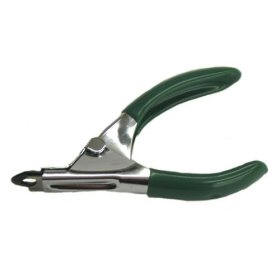Trimming your dog's nails
Check every 2 weeks or when you hear a clicking
sound when your dog walks across the floor
MetPet.com Staff Writer
A dog's nails grow over time like a human's and usually
require routine maintenance. Some lucky dogs never need a trim. Their nails
are relatively soft and/or they wear them down through daily use usually by walking on
hard surfaces.
A dog's nails should barely touch the ground. If the
nails are too long, they can cause the feet to splay (spread out) creating discomfort and
possible deformation of the foot. Severely overgrown nails can actually curl under
the foot and pierce the pads at the bottom of the feet. Long nails are prone to
breakage usually at the base. Broken nails can be very painful. They can
become infected and require a trip to the vet.
Types of trimmers
  There are two basic types of clippers: guillotine and scissors. With the guillotine
type you place each toenail into a rounded slot, squeeze the handles together and a blade
comes up and cuts the tip of the nail off. There are two basic types of clippers: guillotine and scissors. With the guillotine
type you place each toenail into a rounded slot, squeeze the handles together and a blade
comes up and cuts the tip of the nail off.
The
scissors type has short, squared or rounded blunt blades with a round opening
specifically for cutting nails. Dog nails are round and tough so human
nail clippers will not work well if at all.

The
guillotine type of clipper is a bit more difficult to use but has more leverage for tough
nails.  This type of clipper has to be kept very sharp otherwise it will simply crush
the nail without cutting it. For small dogs, the scissors type is probably
easiest to handle. The scissors type of dog nail clipper also makes it
easy to see both sides of the nail while clipping.
This type of clipper has to be kept very sharp otherwise it will simply crush
the nail without cutting it. For small dogs, the scissors type is probably
easiest to handle. The scissors type of dog nail clipper also makes it
easy to see both sides of the nail while clipping.
The nails
Dogs are digitigrade mammals. Digitigrade mammals unlike plantigrade
mammals such as bears and humans, walk on their digits or toes.
Most dogs have 5 toenails (or claws) on each foot. The fifth nail or dewclaw does
not touch the ground and is found well up on the leg. It can be removed soon after birth since it does not appear to
have a function and can become a nuisance. Since the dewclaw does not touch the
ground, it does not get worn and needs to be clipped. In addition, it can snag on
hosiery, bushes, etc. and be torn off resulting in a bloody and painful mess.
Some
breed standards require dewclaws to remain intact so check with your breeder or
the relevant breed organization (AKC, UKC, etc.) if you are planning to show your dog. If your dog has all his nails, all of
them need to be maintained. Dewclaws can be surgically removed on an older dog but
the operation requires general anesthesia and can be quite painful and expensive.
 The
epidermis and the quick The
epidermis and the quick
The nail consists of an epidermis, or outer layer which is what we see. It
can range in color from an opaque black to essentially transparent. Some
dogs have nails of different colors.
The easiest nails to trim are those that are transparent. The quick is
easily visible as a pinkish triangle and can be easily avoided. The most
difficult nails to trim are those that are large, tough and black.
Within the epidermis is the dermis or quick which is shown
here in pink. The quick has blood vessels and nerve endings. When cutting
nails, it is essential to avoid cutting into the quick.  Even though it can make
your dog uncomfortable, cutting just the tip of the epidermis does not cause any
pain. However, cutting into the quick will cause the nail to bleed and your dog will
likely squeal in pain and run away. Even though it can make
your dog uncomfortable, cutting just the tip of the epidermis does not cause any
pain. However, cutting into the quick will cause the nail to bleed and your dog will
likely squeal in pain and run away.  If that happens, apply a styptic pencil or
powder to the end of the nail to stop the blood. Alternatively, apply gentle
pressure for a few minutes with a clean tissue or towel until the bleeding stops. If
the bleeding is severe, you will need to bandage it and/or see your vet. Styptic
powders are widely available at pet stores. If that happens, apply a styptic pencil or
powder to the end of the nail to stop the blood. Alternatively, apply gentle
pressure for a few minutes with a clean tissue or towel until the bleeding stops. If
the bleeding is severe, you will need to bandage it and/or see your vet. Styptic
powders are widely available at pet stores.
Page 1 2 >
|
